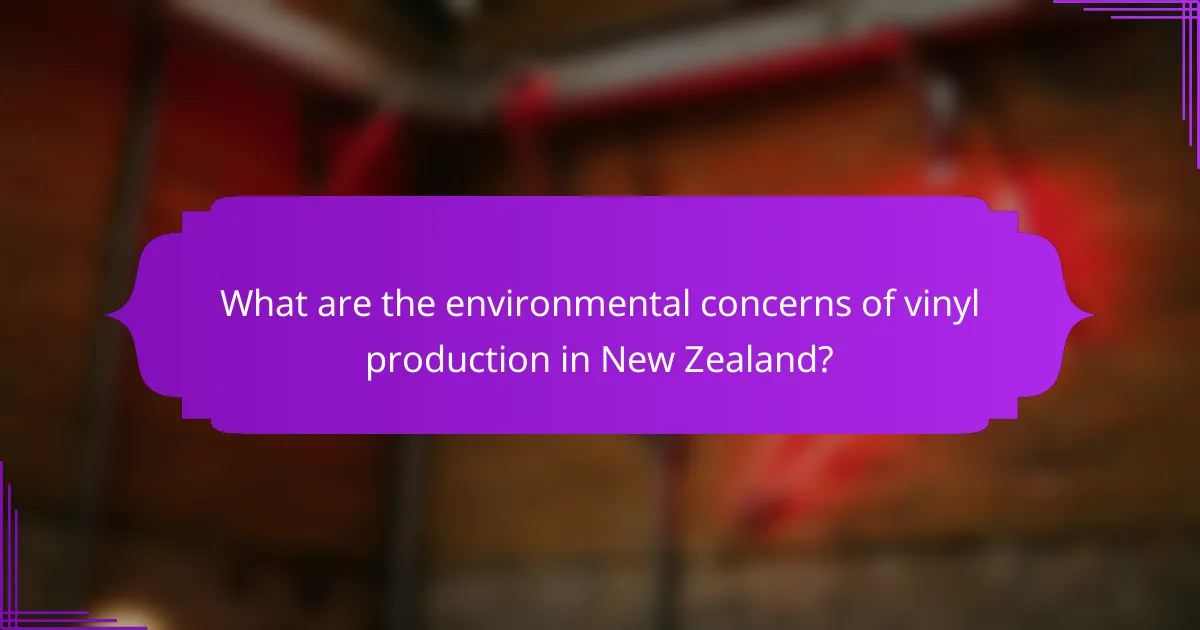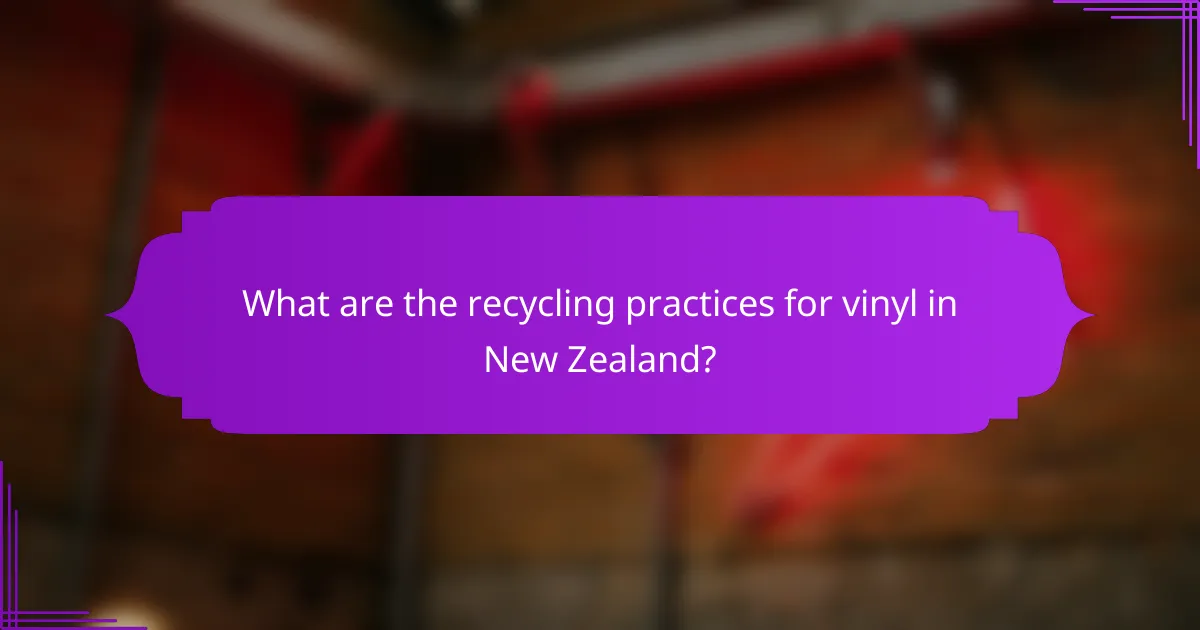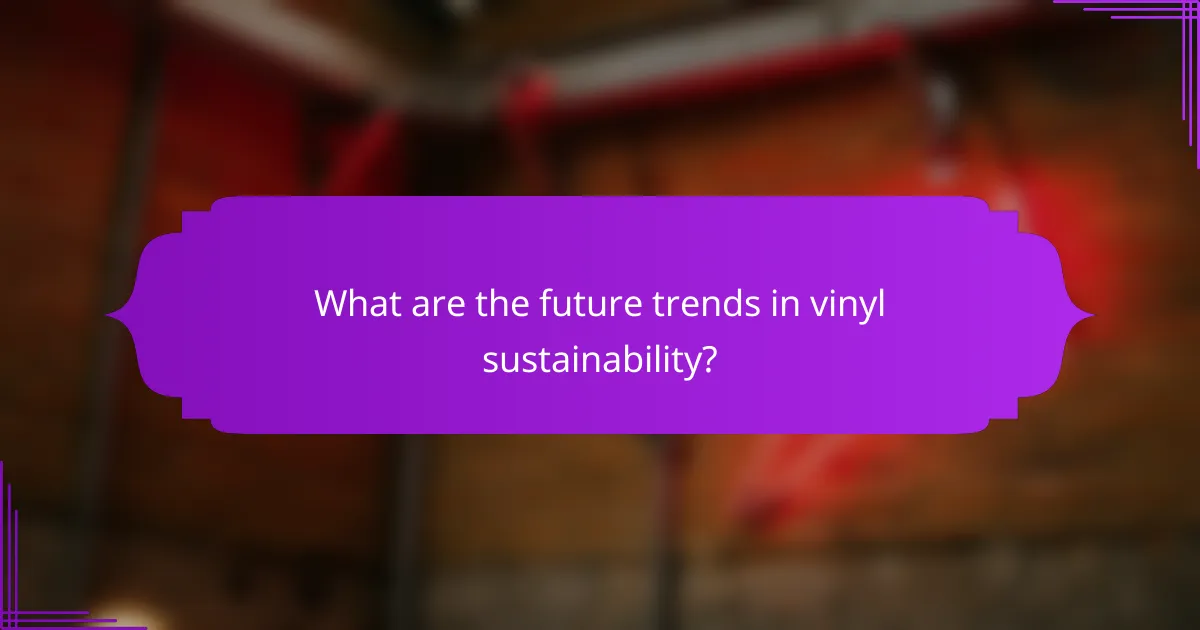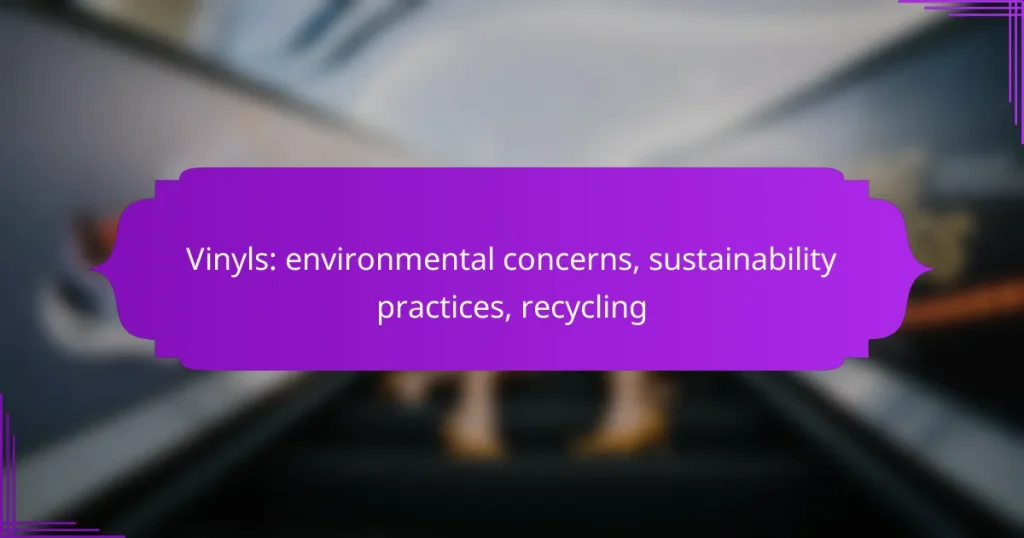The production of vinyl poses significant environmental challenges, including air pollution and water contamination, which can adversely affect local ecosystems and public health. However, by adopting eco-friendly materials and energy-efficient methods, the vinyl industry can enhance sustainability and reduce its carbon footprint. In New Zealand, effective recycling practices are being implemented to process and repurpose vinyl, promoting resource conservation and minimizing waste.

What are the environmental concerns of vinyl production in New Zealand?
The production of vinyl in New Zealand raises several environmental concerns, primarily related to air pollution, water contamination, and the overall carbon footprint. These issues stem from the materials and processes used in vinyl manufacturing, which can have significant effects on local ecosystems and public health.
Air pollution from manufacturing
Vinyl production can release various pollutants into the air, including volatile organic compounds (VOCs) and particulate matter. These emissions can contribute to smog formation and respiratory issues among nearby populations. New Zealand’s regulations aim to limit these emissions, but compliance can vary among manufacturers.
To mitigate air pollution, companies can adopt cleaner technologies and processes, such as using water-based adhesives and minimizing solvent use. Consumers can also support manufacturers that prioritize sustainable practices, thereby encouraging industry-wide improvements.
Water contamination risks
The vinyl production process can lead to water contamination through the discharge of harmful chemicals into local waterways. These contaminants can affect aquatic life and potentially enter the drinking water supply. In New Zealand, strict environmental regulations are in place to monitor and control wastewater discharge, but enforcement and compliance are crucial.
Manufacturers can reduce water contamination risks by implementing closed-loop systems that recycle water and treat wastewater before release. Consumers should be aware of the sourcing of vinyl products and opt for those produced with environmentally responsible practices.
Carbon footprint of vinyl products
The carbon footprint of vinyl products encompasses emissions from raw material extraction, manufacturing, transportation, and disposal. Vinyl production is energy-intensive, often relying on fossil fuels, which contributes to greenhouse gas emissions. In New Zealand, the push for renewable energy sources is vital to reducing this footprint.
To minimize the carbon impact, consumers can choose vinyl products made from recycled materials or those produced using renewable energy. Additionally, supporting local manufacturers can reduce transportation emissions, further lowering the overall carbon footprint associated with vinyl products.

How can vinyl be made more sustainable?
Vinyl can be made more sustainable through the use of eco-friendly materials, energy-efficient production methods, and the implementation of circular economy principles. These practices not only reduce environmental impact but also promote resource conservation and waste reduction.
Use of bio-based materials
Incorporating bio-based materials into vinyl production can significantly enhance sustainability. These materials, derived from renewable resources like corn or sugarcane, can replace traditional petroleum-based inputs, reducing carbon footprints and reliance on fossil fuels.
For example, some manufacturers are experimenting with bioplastics that mimic the properties of conventional vinyl while being more environmentally friendly. This shift can lead to a lower environmental impact throughout the product lifecycle.
Energy-efficient production processes
Energy-efficient production processes are crucial for making vinyl more sustainable. By optimizing manufacturing techniques, companies can decrease energy consumption, which often involves transitioning to renewable energy sources like solar or wind power.
Implementing technologies such as heat recovery systems can further minimize energy waste. Manufacturers that adopt these practices can see reductions in operational costs and greenhouse gas emissions, contributing to a more sustainable industry.
Adoption of circular economy principles
Adopting circular economy principles involves designing vinyl products for longevity, reparability, and recyclability. This approach encourages manufacturers to create products that can be reused or repurposed, reducing waste and resource depletion.
For instance, establishing take-back programs allows consumers to return used vinyl products for recycling, ensuring that materials are reintegrated into the production cycle. This not only conserves resources but also minimizes landfill contributions, fostering a more sustainable lifecycle for vinyl products.

What are the recycling practices for vinyl in New Zealand?
In New Zealand, recycling practices for vinyl involve collection, processing, and repurposing of vinyl materials, primarily through specialized facilities. These practices aim to reduce waste and promote sustainability in the vinyl industry.
Local recycling programs for vinyl
New Zealand has several local recycling programs that focus on vinyl products, particularly in urban areas. These programs often involve drop-off points for vinyl waste, where consumers can dispose of items like old records, vinyl flooring, and signage. Some councils collaborate with private companies to ensure that collected vinyl is processed correctly.
For example, Auckland and Wellington have initiatives that facilitate the recycling of vinyl, providing residents with clear guidelines on how to participate. Community awareness campaigns also help educate the public on the importance of recycling vinyl materials.
Challenges in vinyl recycling
Recycling vinyl presents several challenges, including contamination and the complexity of separating different types of plastics. Many vinyl products are mixed with other materials, making it difficult to recycle them effectively. Additionally, the lack of widespread facilities capable of processing vinyl can limit recycling efforts.
Another significant challenge is the economic viability of recycling vinyl. The cost of collection and processing often outweighs the financial benefits, leading some recyclers to prioritize other materials over vinyl. This can result in a lower recycling rate for vinyl products.
Innovative recycling technologies
Innovative recycling technologies are emerging to address the challenges of vinyl recycling in New Zealand. For instance, advanced sorting systems and chemical recycling methods are being developed to improve the efficiency of separating and processing vinyl materials. These technologies can help recover valuable resources from vinyl waste.
Some companies are experimenting with upcycling vinyl into new products, such as furniture or art installations, which can provide alternative uses for recycled materials. These innovations not only reduce waste but also promote a circular economy within the vinyl industry.

What are the benefits of recycling vinyl?
Recycling vinyl offers significant advantages, including reducing environmental impact and promoting sustainability. By reprocessing used vinyl products, we can minimize waste and conserve valuable resources.
Reduction of landfill waste
Recycling vinyl significantly decreases the amount of waste sent to landfills. Vinyl, being a durable material, can take decades to decompose, contributing to long-term environmental issues. By recycling, we divert these materials from landfills, helping to alleviate space constraints and reduce pollution.
Communities can implement local recycling programs that accept vinyl products, encouraging residents to participate. This collective effort can lead to a noticeable reduction in landfill contributions over time.
Conservation of natural resources
Recycling vinyl helps conserve natural resources by reducing the need for new raw materials. The production of new vinyl requires significant amounts of petroleum, a non-renewable resource. By recycling existing vinyl, we lessen the demand for these resources, promoting a more sustainable approach to material use.
Additionally, recycling processes often consume less energy compared to producing new vinyl. This energy savings translates into lower greenhouse gas emissions, further benefiting the environment.
Economic benefits of recycled vinyl products
Recycling vinyl can lead to economic advantages by creating a market for recycled products. Companies that utilize recycled vinyl often experience lower production costs, which can translate into savings for consumers. This can make recycled vinyl products more competitive in pricing compared to their virgin counterparts.
Furthermore, the recycling industry can create jobs in collection, processing, and manufacturing sectors. As demand for recycled vinyl grows, so does the potential for job creation in local economies, contributing to overall economic health.

What are the key players in sustainable vinyl practices?
Key players in sustainable vinyl practices include industry councils, manufacturers, and collaborative initiatives focused on reducing environmental impact. These entities work together to promote recycling, sustainable production methods, and responsible material sourcing.
New Zealand Vinyl Council
The New Zealand Vinyl Council plays a crucial role in promoting sustainability within the vinyl industry in New Zealand. It focuses on developing best practices for vinyl production and usage, emphasizing the importance of recycling and reducing waste. The council also engages with stakeholders to raise awareness about the environmental benefits of vinyl products when managed responsibly.
Leading sustainable vinyl manufacturers
Several manufacturers are at the forefront of sustainable vinyl production, implementing eco-friendly practices and technologies. Companies like Tarkett and Armstrong are known for using recycled materials in their products and adopting energy-efficient manufacturing processes. These manufacturers often seek certifications that demonstrate their commitment to sustainability, such as ISO 14001 for environmental management.
Collaborative initiatives in the industry
Collaborative initiatives within the vinyl industry aim to enhance sustainability through partnerships and shared goals. Programs like VinylPlus in Europe focus on increasing the recycling rate of vinyl products and promoting circular economy practices. These initiatives often involve multiple stakeholders, including manufacturers, recyclers, and government bodies, working together to create a more sustainable vinyl lifecycle.

What are the future trends in vinyl sustainability?
Future trends in vinyl sustainability focus on reducing environmental impact through innovative materials and recycling practices. The industry is increasingly adopting eco-friendly production methods and exploring alternatives to traditional vinyl to enhance sustainability.
Innovative materials in vinyl production
Innovative materials are transforming vinyl production by incorporating bio-based and recycled components. Manufacturers are experimenting with plant-based additives and recycled PVC, which can significantly lower the carbon footprint of new vinyl products. This shift not only reduces reliance on fossil fuels but also promotes circular economy principles.
Advancements in recycling technologies
Advancements in recycling technologies are crucial for improving vinyl sustainability. New processes allow for more efficient separation and processing of vinyl waste, enabling higher recycling rates. For instance, chemical recycling methods can break down vinyl into its original monomers, allowing for the creation of new, high-quality vinyl products.
Regulatory influences on vinyl sustainability
Regulatory influences are shaping the future of vinyl sustainability by setting standards for environmental practices. In many regions, regulations are being introduced to limit harmful substances in vinyl production and promote recycling initiatives. Compliance with these regulations not only helps protect the environment but can also enhance brand reputation and consumer trust.
Consumer demand for sustainable products
Consumer demand for sustainable products is driving the vinyl industry to adopt greener practices. As more consumers prioritize eco-friendly options, manufacturers are responding by offering vinyl products that are marketed as sustainable. This trend encourages companies to invest in sustainable technologies and practices to meet consumer expectations.


